In a lot of cases, you probably pack your goods in cardboard boxes. And that’s usually an excellent choice too! But there are obviously exceptions to every rule… What if your goods need extra robust protection, for example? Or when you export to the other side of the world? In that case, the solution is wooden transport boxes. Packaging expert RAJA gathered all the expert advice for you so you can use these crates like a real pro!
1. When do you use wooden transport crates?
A shipping crate or export crate is particularly useful for packing and protecting your goods in a number of cases. In the situations below, it is best to consider using this packaging material.
- Situation 1: transporting heavy products.
Wooden crates are much more robust than corrugated cardboard boxes, even if you were to opt for a thick triple corrugated. This makes crates ideal for packing very heavy goods (such as machinery) or more fragile items (such as electronics and works of art)
. - Situation 2: exporting goods.
For international transport by train, sea or air, it is safer to choose very strong packaging. Such packaging is preferably more resistant to temperature fluctuations, weather conditions and shocks. The good news for you is that wooden transport crates make all this possible.
- Situation 3: palletising goods.
For this, you can use a ‘pallet box‘. This is basically a transport box with an integrated pallet at the bottom (you’ll read more about that later). They guarantee optimal load securing and stability. Thanks to the open slots at the bottom, you can move the crate smoothly and safely with a pump truck.
- Situation 4: long-term durable storage of items.
Wooden shipping crates are the ideal packaging for long-term storage, even in difficult conditions. Think of environments with a lot of moisture or large temperature fluctuations, among other things.
Do any of these situations apply to your business? Then check out how to choose the ideal wooden transport box for your shipments below.
2. How to choose the right wooden transport box?
In the transport market, there is absolutely no shortage of wooden packaging solutions. The following points of interest will ensure you make the right choice.
► 2.1 Check that the crate complies with the ISPM15 standard
If you ship your goods outside EU borders, then you have probably heard of the ISPM15 standard. This stands for the International Standard for Phytosanitary Measures. This standard applies to packaging material made of raw wood thicker than 6 mm. The wood is treated at a very high temperature so that harmful organisms and pests cannot spread from one continent to another.
Packaging meeting the standard is indelibly marked with a symbol in the shape of an ear of corn (as you can see in the image below). More information on the composition and meaning of this symbol can be found in this blog article on the ISPM15 standard for wooden pallets. The ISPM15 standard is mandatory in quite a few countries outside the EU, including, for example, South Africa, Canada, China, the United States, India and Turkey.
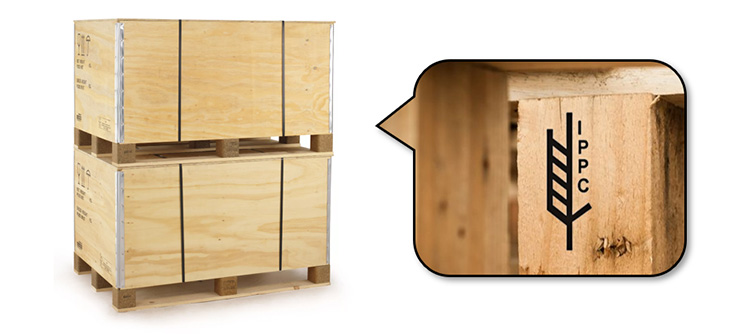
► 2.2 Choose plywood
Not all wooden transport packaging is made from the same basic material. Want to combine sturdiness with low weight? Then choose plywood instead of solid wood.
Thanks to its composition, this type of wood is highly resistant to shocks during transport. Moreover, you are assured of a low weight that will affect your transport costs less. The result is packaging that is easier to handle and offers optimal protection. Plywood transport boxes are popular when transported in sea containers, freight wagons or trucks.
RAJA’s export crates are typically made of plywood with five crossed layers. Each layer is glued together with phenol, an adhesive that guarantees high moisture resistance.
► 2.3 Check the sustainable nature of your packaging
On the one hand, we see that environmental standards for packaging are getting stricter and stricter. On the other hand, customer expectations are also rising when it comes to sustainable packaging. It is therefore in your best interest to choose packaging made of environmentally friendly materials.
Most of RAJA’s wooden packaging, for instance, is made of FSC-certified raw material. This means that the wood comes from sustainably managed forests. So, among other things, you can be sure that the felled trees were replaced by new ones. The same wooden packaging is also easy to recycle after its use so that it forms the basis of new wooden, cardboard or paper products.
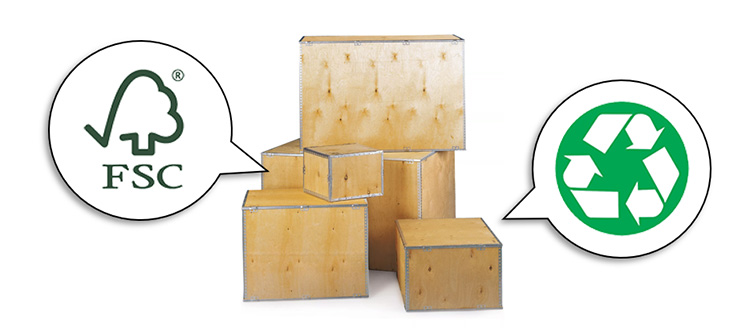
► 2.4 Choose the correct height of your pallet’s skids
Smart packing and shipping of your wooden shipping crates is not only about what is inside your crate, but also about what is underneath it. What we are mainly talking about are the skids at the bottom of a pallet. As standard, these are often about 2 to 5 cm high. But you also have ones with a height of 10 cm. This is ideal for easy handling with a pallet truck. You can then slide the pallet truck forks under your crate more smoothly.
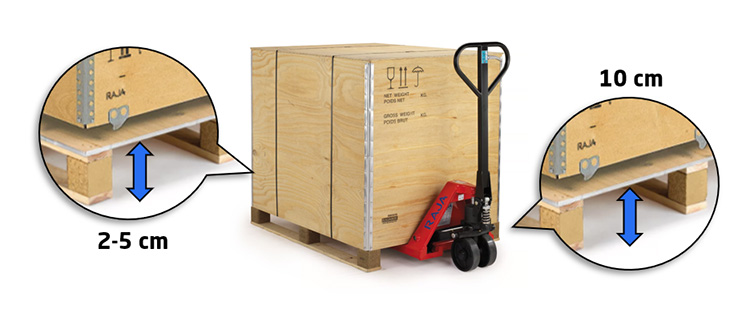
Bespoke wooden transport boxes also exist? No two loads are the same, so it may already happen that the shape of a standard wooden crate is not well suited to the goods you want to pack. In that case, you can use pallet top edges. You simply stack the edges on top of each other until you reach the desired size.
3. How do you assemble a transport crate?
Assembling wooden transport crates is easy by following the steps below. The crates are usually foldable and delivered flat. At RAJA, we usually deliver our crates in 3 separate parts: bottom, wall and lid.
- Step 1: Create a base.
The base of your transport crate is easily formed by placing the loose bottom or a separate pallet on the ground and mounting your walls on it. Those walls are easy to prop up and connect around the bottom
. - Step 2: Reinforce the walls.
Use a hammer to fold the locking tongues of the walls. This ensures that the walls will always keep their shape and that it forms a solid unit with the bottom. Are you using a chest without struts? If so, it’s best to screw the walls additionally into the bottom with a light drill.
- Step 3: Close with a lid or strapping.
After you have placed your goods in the crate, you can close the top with a lid. In some crates, you can use a hammer to bend the closing tongues of the walls to do this. With other crates that do not have locking tongues, it is advisable to surround the entire transport crate with a strong strapping band. Then you create a solid whole.
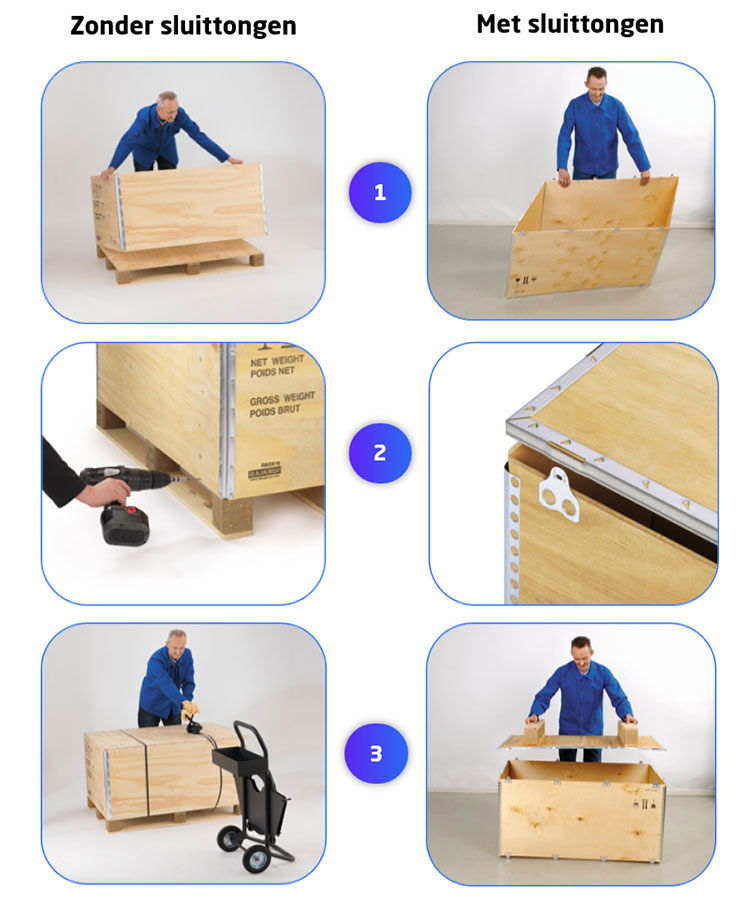
4. RAJA’s most popular wooden transport boxes
Pallet box with 2 skids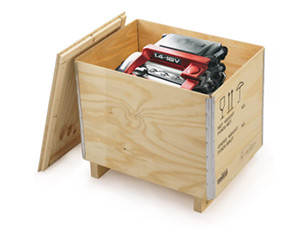 |
Pallet box with 3 skids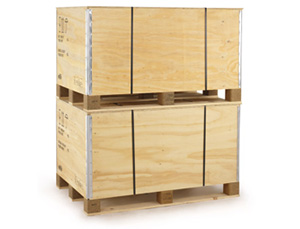 |
Export crate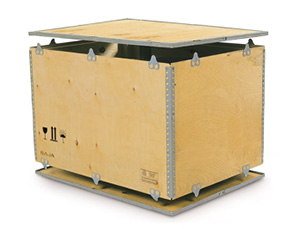 |
| – For light to medium loads (max. 400 kg depending on model). – To be moved with a pump truck. – Suitable for export outside the EU. |
– For heavy loads (max. 1000 kg depending on model). – To be moved with a pump truck. – Suitable for export outside the EU. |
– For medium to heavy loads (max. 1000 kg depending on model). – Quick assembly and closure, a hammer is sufficient. – Suitable for export outside the EU. |














